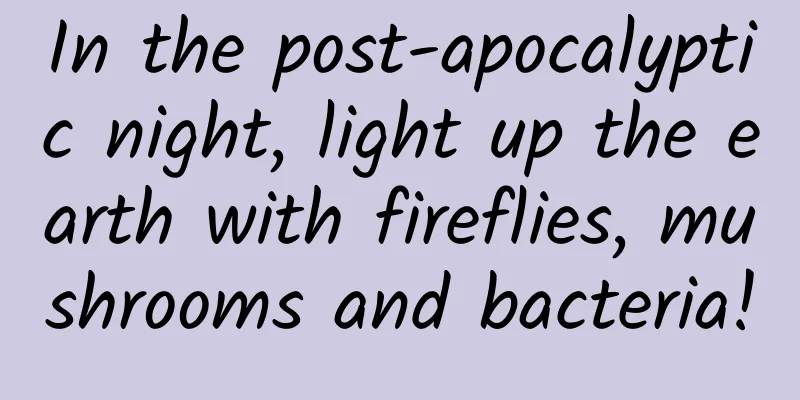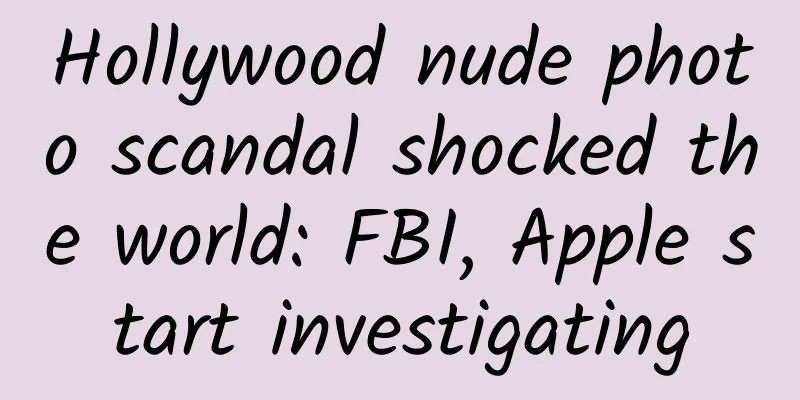In the post-apocalyptic night, light up the earth with fireflies, mushrooms and bacteria!

|
On the riverside of the French city of Sens, tubes filled with bacteria stand on the river bank, emitting a faint blue-green light. The faint green light on the river bank|Glowee Unlike glaring lights, this blue-green light is very soft. Similar to the glow of fireflies, it does not require electricity, but emits light through the natural metabolism of marine bacteria, which is a kind of biological lighting. These riverside light tubes are the first outdoor bio-lighting installations from French bio-lighting company Glowee. In addition, Glowee has also installed such lights in the vaccine observation area, where people can bathe in the gentle blue-green light and calmly wait for time to pass. Glowee is a French startup that produces bioluminescent lighting devices, hoping to change the way cities use lights. It has also reached cooperation with some French towns to promote these blue fluorescent bioluminescent lights. Glowee In the Glowee Lab, these bioluminescent devices are even more fantastical. Various containers filled with marine bacteria emit blue-green fluorescence in the lab, giving people the illusion of entering the Matrix. The Matrix in the lab|Glowee There are a few chairs placed under fluorescent lights dressed up as flowers, plants and trees. The researchers in the laboratory use this as a place to relax, bathing in the light natural glow and enjoying a good time together. Is this light meant for people to sleep during work hours?|Glowee No electricity is needed, nutrients and oxygen are enough The protagonist of the Glowee bioluminescence installation is Vibrio fischeri, a bioluminescent marine bacterium. Glowee collected Vibrio fischeri from the French coast, stored them in test tubes filled with salt water, and then transferred them to "aquarium-like" containers for cultivation. Vibrio fischeri grown in the lab | Glowee As long as nutrients and air are injected into the container, the marine bacteria can carry out relevant biochemical reactions and emit light under aerobic conditions; if you want to "turn off the lights", you can also cut off the air and let the bacteria enter the anaerobic state. Why can Vibrio fischeri emit light? Because this bacterium contains luciferase. Luciferase can participate in the chemical reaction of energy substances in the body, convert chemical energy into light energy, and finally release blue fluorescence with a wavelength of about 490nm. This marine bacteria comes from a very magical deep-sea species - the "luminous squid". The Hawaiian bobtail squid is a nocturnal marine creature that often forages at night. Vibrio fischeri can coexist with it, glowing with the brightness of moonlight, illuminating the sea area under the bobtail squid, making the bobtail squid "invisible" to avoid attacks by predators. What organisms can emit light? Blue, green, and red light Living things in nature can emit more than just blue light. The fluorescent molecules contained in living things have different structures, so they emit a variety of colors. Most marine bioluminescent organisms emit blue-green light, which can travel farther in the ocean because of its shorter wavelength. For example, when the seawater around it is stirred, the timid dinoflagellates will emit blue light due to stimulation, and when a large group of dinoflagellates is disturbed, a large area of shimmering blue light will appear on the sea surface, forming a beautiful fluorescent beach. Fluorescent beach, dinoflagellates emit blue light when disturbed by waves, ships, etc. | Eleanor Hamilton Some mushrooms emit green light, such as the luminous fungus Roridomyces phyllostachydis, which was first discovered by Chinese and Indian scientists during a joint expedition. It grows in Meghalaya, northeastern India, and only the stem glows. It only grows on dead bamboo, and the glow may be to attract insects to help disperse spores or to avoid being eaten by animals. Locals do not eat this mushroom, but will collect dead bamboo with mushrooms as a natural "torch". Mushrooms that glow only at the stem | Reference [7] Some creatures emit more dazzling light, such as the spring rabbit (Pedetes capensis), a nocturnal animal whose hair can produce a bright pink fluorescence under ultraviolet light. Scientists are not sure why it emits such a bright red color, but it may be used to confuse predators that are sensitive to ultraviolet light and save their lives. You may not be able to see this red with your naked eyes, after all, your eyes are not equipped with ultraviolet light | Reference [2] Could bioluminescence really light up our cities? Although biological lighting draws on nature and has many advantages such as environmental protection, energy saving, and renewable, it still faces considerable challenges as a lighting method. The most fatal drawback is that the biological lighting is not bright enough and the lighting time is also very short. Glowee's current biological lighting can only achieve 15 lumens per square meter, while public lighting in parks requires at least 25 lumens per square meter, and household LED lights can produce about 111 lumens per square meter. Moreover, unlike stable electric lighting, bacteria have a life cycle, and biological lighting can only last for a few days to a few weeks. A physical unit that describes luminous flux. The larger the lumen, the brighter the light. In Glowee’s visual effect map, the city is not very bright. | Glowee Secondly, bacterial growth requires careful cultivation, adequate nutrition, a clean living environment and a suitable temperature. These operations require regular maintenance by professional personnel, which will consume a lot of manpower, material resources and financial resources. If it is a freezing winter, the growth of bacteria may completely stagnate and biological lighting will be paralyzed. However, if the temperature is raised to maintain the normal life activities of bacteria, a large amount of energy will be consumed, which is not worth the cost. So at present, biological lighting cannot replace electric lighting and can only serve as an auxiliary at best. How about trying gene editing? Since bacterial culture is subject to many restrictions, some researchers choose to directly extract the bacteria's luminescent substance luciferase and allow it to glow on its own. The Nyoka Design Laboratory in Canada has developed a biological lighting device - a degradable fluorescent stick that does not use bacteria but directly uses extracted luminescent proteins, which are easier to maintain than living bacteria. The fluorescent sticks developed by Nyoka's laboratory use fluorescent proteins. Common fluorescent sticks use peroxides, ester compounds and fluorescent dyes. After shaking or bending, the peroxides and ester compounds react, and then transfer the energy from the reaction to the fluorescent dye, which finally emits fluorescence. | Nyoka But biodegradable glow sticks can only be used for purposes such as music festivals and are thrown away after use. They cannot replace the lighting system. Is there a more lasting method? Some scientists have turned their attention to gene editing technology. Thirty years ago, scientist Keith Wood used the genes of fireflies to create the first glowing plant. He believed that this technology could replace artificial lighting such as LEDs to a certain extent. In 2012, Wood's team discovered that by changing the genetic structure of a luciferase in deep-sea shrimp (opplophorus gracilirostris), its brightness could be increased 2.5 million times, and the resulting enzyme was 150 times brighter than the luciferase found in fireflies. Transgenic tobacco plant B21 carrying the firefly luciferase gene | Keith Wood In April 2020, a team from Russia invented a method to maintain bioluminescence. They transplanted the bioluminescent gene from fungi into plants. The effect of mushrooms and plants was particularly good. The light emitted by the plants was 10 times brighter than before and lasted longer. Keith Wood also founded light bio, a company focused on creating indoor luminous plants|light-bio.com However, it may be some time before these plants can become street lights. Designers from Athens believe that if each luminous plant can emit about 57 lumens of light, then 40 plants must be planted every 30 meters on both sides of the road to meet the lighting needs. Of course, it is also possible that biological lighting devices do not need to replace electric lighting at all, but instead flow between you and me as a natural glow. Just imagine that when night falls, the dazzling and fancy LED lights go out, and the square is lit up with a faint green or blue light. People's tense vision and spirit return to relaxation, and even if they have never seen fireflies in the city, they can feel the connection with nature again. This may be what bioluminescence brings, a comfortable relationship between humans and nature. The Glowee bioluminescent device says: "Scrute la nature, c'est là qu'est ton futur." Translated, it is a famous quote by Leonardo da Vinci, "Scrute nature, that's where your future lies."|Glowee References [1]Visick KL, Stabb EV, Ruby EG. A lasting symbiosis: how Vibrio fischeri finds a squid partner and persists within its natural host. Nat Rev Microbiol. 2021 Oct;19(10):654-665. doi: 10.1038/s41579-021-00557-0. Epub 2021 Jun 4. PMID: 34089008; PMCID: PMC8529645. [2]Olson ER, Carlson MR, Ramanujam VMS, Sears L, Anthony SE, Anich PS, Ramon L, Hulstrand A, Jurewicz M, Gunnelson AS, Kohler AM, Martin JG. Vivid biofluorescence discovered in the nocturnal Springhare (Pedetidae). Sci Rep. 2021 Feb 18;11(1):4125. doi: 10.1038/s41598-021-83588-0. PMID: 33603032; PMCID: PMC7892538. [3]Ow DW, DE Wet JR, Helinski DR, Howell SH, Wood KV, Deluca M. Transient and stable expression of the firefly luciferase gene in plant cells and transgenic plants. Science. 1986 Nov 14;234(4778):856-9. doi: 10.1126/science.234.4778.856. PMID: 17758108. [4]Bevilaqua VR, Matsuhashi T, Oliveira G, Oliveira PSL, Hirano T, Viviani VR. Phrixotrix luciferase and 6'-aminoluciferins reveal a larger luciferin phenolate binding site and provide novel far-red combinations for bioimaging purposes. Sci Rep. 2019 Jun 21;9(1):8998. doi: 10.1038/s41598-019-44534-3. PMID: 31227722; PMCID: PMC6588592. [5]Karunarathna SC, Mortimer PE, Tibpromma S, et al. Roridomyces phyllostachydis (Agaricales, Mycenaceae), a new bioluminescent fungus from Northeast India[J]. Phytotaxa, 2020, 459(2):155–167. [6] DUTTA, AK, PALOI, S., HU, Y., BAURAH, G., AXFORD, S., MARCINIAK, C., ... & LUMYONG, S. (2020). Roridomyces phyllostachydis (Agaricales, Mycenaceae), a new bioluminescent fungus from Northeast India. Phytotaxa, 459(2), 155-167. [7] The French town where the lighting is alivehttps://www.bbc.com/future/article/20220407-the-living-lights-that-could-reduce-energy-use [8] Mitiouchkina T, Mishin AS, Somermeyer LG, Markina NM, Chepurnyh TV, Guglya EB, Karataeva TA, Palkina KA, Shakhova ES, Fakhranurova LI, Chekova SV, Tsarkova AS, Golubev YV, Negrebetsky VV, Dolgushin SA, Shalaev PV, Shlykov D, Melnik OA, Shipunova VO, Deyev SM, Bubyrev AI, Pushin AS, Choob VV, Dolgov SV, Kondrashov FA, Yampolsky IV, Sarkisyan KS. Plants with genetically encoded autoluminescence. Nat Biotechnol. 2020 Aug;38(8):944-946. doi: 10.1038/s41587-020-0500-9. Epub 2020 Apr 27. Erratum in: Nat Biotechnol. 2020 Jun 4;: PMID: 32341562; PMCID: PMC7610436. Author: Yaxie Editor: Xiao Towel, You Shiyou An AI If I also grow some marine bacteria, I will become a luminous AI! This article comes from Guokr and may not be reproduced without permission. If necessary, please contact [email protected] |
<<: Future Computing Atlas: What will computing look like in ten years?
>>: Satellite shows you: China's creations on the wasteland
Recommend
If you want to promote something, you must understand the Points Wall. This article will give you a comprehensive understanding of the Points Wall!
1. What is the Points Wall ? The "Points Wal...
Popular Science | Answers to common questions about orthokeratology lenses
Recently, many parents and friends have come to o...
Learn ASO from scratch: 10 minutes to help you fully master ASO!
According to the latest statistics, China has bec...
Construction and operation of private domain traffic!
When some brands engage in " private domain ...
Advanced Operations: Analysis of the underlying logic of the user incentive system!
Common incentive systems include point systems, g...
Online literature and movies: How do they complement each other?
There is a view that the flourishing Chinese lite...
Why do we need quantum computing?
Author's Note At the request of a friend, I w...
Heytea’s operational skills for its tens of millions in private domain revenue!
According to online information, on January 31 of...
Why do people get “scared”?
Science Fiction Network, December 22 (Jin Kaiyi) ...
China Electronics Technology Standardization Institute: White Paper on Enterprise Digital Transformation (2021 Edition)
The digital economy is the future development dir...
The non-stick pan turned sticky! Did I eat the coating?
In 1938, Americans accidentally discovered a slip...
A complete breakdown of the strategy for creating explosive products!
Ask a question I have come into contact with many...
Hangzhou Internet Entrepreneurship Guide 3.0 2015
[[152981]] This Hangzhou Internet Entrepreneurshi...
IBM's latest quantum computing progress: Is quantum computing's chatGPT moment coming soon?
In June 2023, IBM Quantum and its partners, inclu...
Keep Fitness 43 sets of member video collection
Keep Fitness 43 sets of member video collection r...









